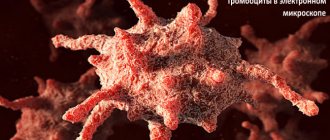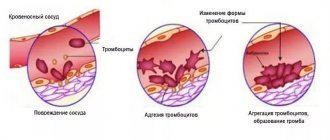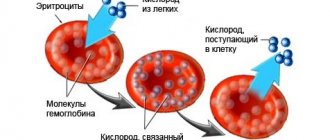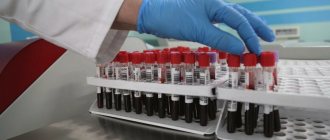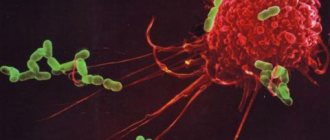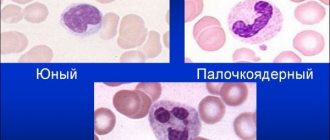Causes of low monocytes
The normal content of monocytes in the blood relative to the total number of leukocytes is
- in adults – 3-11%;
- in children – 2-10%.
So, what can cause low monocytes?
A severe infectious disease initially causes a surge in the formation of phagocytes, but a long-term fight against the disease, the use of antibiotics and especially steroidal anti-inflammatory drugs lead to the fact that the generation of white blood cells decreases. Along with monocytes, the level of ordinary leukocytes decreases. The generation of monocytes is also suppressed
- long-term use of glucocorticosteroid drugs;
- chemical poisoning;
- ionizing or radiation radiation;
- severe stress.
All these factors lead to exhaustion of the body, which in turn leads to a decrease in monocytes. But if these factors are removed from the patient’s life, normal nutrition is provided, the biochemical and cellular composition of the blood will be restored. It is more difficult to cope with bone marrow diseases and blood pathologies.
Why is the value lowered?
Various reasons lead to low levels of monocytes in the blood. These include viruses, cancer, infections, autoimmune disorders, etc. Low monocytes are observed in patients undergoing chemotherapy because chemotherapy drugs affect the overall content of immune cells in the blood.
In men
When monocyte levels are low in adults, this indicates the presence of a disease or the influence of physiological factors on the test results. Physiological factors that affect the number of monocytes:
- severe stress;
- starvation;
- side effect from taking medications (cytostatics, corticosteroids);
- pain shock.
If monocytes are low in an adult, this indicates the following pathologies:
- bone marrow failure syndrome;
- enteritis;
- vitamin B12 deficiency;
- tuberculosis;
- lupus;
- HIV or AIDS;
- rheumatoid arthritis;
- Epstein-Barr virus;
- leukemia (blood cancer).
Among women
When a woman has low monocytes in her blood, this means that she is most likely pregnant. During this period, there is a decrease in almost all blood cells.
Low monocytes in the blood of women during pregnancy can also be caused by low levels of folic acid in the body, which is necessary to prevent birth defects in the baby's brain and spinal cord.
If a blood test shows that monocytes are below normal, this means that the woman needs consultation and examination by a female gynecologist. This is necessary to exclude or confirm sexually transmitted infections. This is a possible reason for the decline in the indicator.
Important information: What do low platelets in the blood indicate during pregnancy (increasing foods)
In children
In children, monocytopenia is often associated with changes in the general picture of the blood condition. A decrease in the number of cells can be caused by the following diseases and conditions:
- traumatic injuries, burns;
- condition after surgery;
- oncology and the consequences of its treatment;
- with chronic stress, the number of macrophages in the blood decreases, as well as other immune cells: stress hormones constrict blood vessels in the bone marrow, suppress the proliferation of all hematopoietic cells, especially leukocytes;
- excess glucocorticoid hormones coming from outside, or natural hormones of the adrenal glands: the condition is called Itsenko-Cushing syndrome;
- long-term use of hormonal anti-inflammatory drugs;
- aplastic anemia - bone marrow failure, as a result of which these cells cease to form;
- foci of inflammation in the body;
- progression of an acute or severe infectious disease, in which the absolute content of monocytes is reduced, for example, typhoid fever;
- physical exhaustion;
- a sharp decrease in immunity.
Sometimes it happens that there are no monocytes in the test results, and their indicator is “0”. This situation is a sign of a dangerous disease, such as a severe form of leukemia or sepsis (blood poisoning), in which the body alone cannot cope with toxins.
The variety of shapes and types determines the functions
group of cells of the agranulocytic series of leukocytes in terms of forms of activity.
(non-granular leukocytes).
Due to the special diversity of their functions, these representatives of the leukocyte unit are united into one common mononuclear phagocytic system
(MPS), which includes:
- Peripheral blood monocytes – everything is clear with them. These are immature cells that have just emerged from the bone marrow and do not yet perform the main functions of phagocytes. These cells circulate in the blood for up to 3 days, and then are sent to the tissues to mature.
- Macrophages are the dominant cells of the MFS. They are quite mature, they are distinguished by the same morphological heterogeneity that corresponds to their functional diversity. Macrophages in the human body are represented by:
- Tissue macrophages
(mobile histiocytes), which are distinguished by a pronounced ability for phagocytosis, secretion and synthesis of a huge amount of proteins.
They produce hydralases, which accumulate in lysosomes or escape into the extracellular environment. Lysozyme
, continuously synthesized in macrophages, is a kind of indicator that responds to the activity of the entire MF system (under the influence of activators, lysozyme in the blood increases); - Highly differentiated tissue-specific macrophages
.
Which also have a number of varieties and can be represented by: Immobile, but capable of pinocytosis, Kupffer cells
, concentrated mainly in the liver; - Alveolar macrophages
, which interact with allergens entering the inhaled air and absorb them; - Epithelioid cellslocalized
in granulomatous nodules (focus of inflammation) with infectious granuloma (tuberculosis, syphilis, leprosy, tularemia, brucellosis, etc.) and non-infectious nature (silicosis, asbestosis), as well as with drug exposure or around foreign bodies; - Intraepidermal macrophages
(dendritic cells of the skin, Langerhans cells) - they process foreign antigen well and participate in its presentation; - Multinucleated giant cells
formed from the fusion of epithelioid macrophages.
The norm of monocytes in the blood of women
The content of monocytic cells in female blood is calculated as a percentage of the total number of white blood cells. Information about whether this value corresponds to the norm is found in the leukocyte formula.
The optimal concentration of monocytes is almost independent of age. Before puberty, it should be between three and nine percent. After turning sixteen, the upper limit rises.
The standard content of monocytes in female blood is (%):
- minimum – 3.0;
- maximum – 11.0.
The number of monocytes can also be measured in absolute units - appropriate techniques have been developed for this purpose. They allow you to count the number of cells in one liter of blood. The results are recorded as follows: Mon# *** x109/l.
The quantitative norm is from 0.09 to 0.70 (109/l).
The proportion of monocytes changes under the influence of such physiological factors as:
- emotional overload and stress;
- surgical intervention;
- taking certain medications;
- stomach full of food;
- phase of the menstrual cycle.
The biorhythms of a particular individual also affect fluctuations in the level of monocytes within normal limits.
What to do?
The main goal with monocytopenia is to eliminate the causes that led to the appearance of this symptom, since reduced monocytes are not a separate disease.
You can learn more about monocytes from the following video:
The first stage is a visit to the doctor, who prescribes additional examination and ways to eliminate the established pathology. Basically, treatment includes items such as:
- Changing your diet - you should eat more: meat; rose hip; red fish; buckwheat; garlic; spinach; celery; nuts; onion. At the same time, it is worth reducing the consumption of salt, sugar, and carbohydrate products.
- Taking medications – should only be taken with a doctor’s prescription.
- Daily walks in combination with gymnastics (in the absence of contraindications).
- In case of serious deviations, surgical intervention is required.
Important! Self-medication for monocytopenia is unacceptable.
In conclusion, it is worth recalling that the main task of monocytes is the destruction of harmful microorganisms that can harm the body. Therefore, the patient should pay attention to the level of monocytes after blood sampling, because deviations from the norm often lead to the development of serious pathologies, which are discussed in our material.
What to do if monocytes are not normal
Please note that if, when reading a blood test, you see a problem with monocytes, you should not look for the answer to the question of how to lower monocytes. Why lower their level if they are fighting infection? First of all, you need to contact a specialist who will conduct an examination, carefully collect an anamnesis of the disease and compare test data.
If necessary, additional clarifying studies can be carried out
First of all, you need to contact a specialist who will conduct an examination, carefully collect an anamnesis of the disease and compare test data. If necessary, additional clarifying studies can be carried out.
Attention! Treatment is prescribed only after a diagnosis has been established, that is, the cause of the deviation in the tests has been identified.
Threat with monocytopenia
Monocytopenia is a symptom that should not be ignored
Decreased monocyte counts may be a natural occurrence and not something to worry about, only in pregnant women. However, not always: even pregnant women need to constantly make sure that there are no deviations under the supervision of a doctor.
Maintaining monocyte counts within normal limits is essential. They are protectors that destroy foreign pathological agents, and also fight various infections, fungal diseases and help fight malignant cancer tumors.
In addition to the individual duties of monocytes, they, like other blood cells, perform the following functions:
- Destruction and prevention of the development of potentially dangerous pathogenic bacteria.
- Regulation of the body's immune responses to inflammatory processes.
- Control over protein production.
- Destruction of obsolete, damaged and defective cells from the body.
- Creating a favorable environment for tissue regeneration after external and internal damage.
The role played by monocytes is very important in the overall functioning of the body, so it responds negatively to any decrease in their number.
The origin of monocytes and their normal presence in the blood
Monocytes are a genus of white blood cells that move in the peripheral blood and are responsible for the body's ability to maintain immune balance. Leukocyte cells are mononuclear; the process of producing monocytes occurs in the bone marrow.
Of the total number of leukocytes, monocytes are the largest in size and the most active in behavior. The purpose of monocytes is to cleanse the body of toxins. Monocytes destroy, processing dead cells of the host body and conduct a kind of hunt for harmful microorganisms.
Monocytes, in fact, occupy the same position in the body as neutrophils, but unlike the latter, they can carry out their cleansing activities in acidic environments without losing their efficiency. The life span of a monocyte in the body lasts up to 40 hours; subsequently, leukocyte cells are removed from the plasma into the body tissues, where they degenerate into macrophages.
The number of monocytes increases with age and the norm for men and women is considered to be from 3 to 11%, which in absolute quantitative terms is 0.09-0.6x109/l cells. Children's indicators are slightly lower than those of adults and range from 2 to 12%; as the child's age increases, the indicator increases.
Functions of blood monocytes
If the level of monocytes in the blood is reduced, monocytopenia occurs, indicating the occurrence and progression of pathogenic phenomena in the patient’s body.
Monocytes are low in the blood of an adult: what does this mean, how to increase it - About Blood
A monocyte is the largest blood cell, a mature white blood cell that does not have granules. They have the ability to absorb pathogenic cells completely in large quantities, as well as destroy microorganisms in environments with high acid levels.
The content of monocytes in the blood must be monitored, because deviations in any direction from the normative indicators may indicate the presence of certain disorders in the body. Let's consider what dangers low readings may indicate.
What monocyte parameters are low in adults? What is monocytopenia?
Granulated monocytes in the blood
The body of an adult healthy person contains from three to eleven percent of monocytes from the number of leukocytes in the blood (1 ml of blood contains 450 of their cells). The minimum permissible reading of their quantity is 0.04x109/l. The standard level of monocytes varies slightly: to a greater extent depending on age, to a lesser extent - on national characteristics.
If the proportion of monocytes in the blood is less than 0.04x109/l, that is, less than 1% of the number of all leukocytes, this indicates monocytopenia.
Monocytopenia is a decrease in the level of monocytes in the blood relative to their standard number, which is observed in septic processes. With monocytopenia, regulatory mechanisms in cells are disrupted and, as a result, this contributes to:
- favorable conditions for the development of infections in tissues and their rapid transport through the cells of the body;
- transformation of the flora of the intestinal mucosa and respiratory tract into potentially dangerous;
- inflammation of small suppurations;
- loss of information by the body about pathological agents.
Symptoms and signs of low monocytes in adults
Monocytopenia is only a symptom of a certain disease
A deficiency in the number of monocytes cannot be determined by external signs or certain manifestations of disorders in the body. However, frequent illnesses, reduced immunity and slow regeneration of skin lesions may signal that there is a reason to consult a doctor with these symptoms and donate blood from a finger prick for analysis.
Causes of monocytopenia
A decrease in the number of monocytes is associated with problems in their synthesis, for which the bone marrow is responsible.
A reduced level of monocytes (monocytopenia) is favored by the following factors:
- various types of anemia;
- leukemia;
- acute infectious diseases (they are characterized by a general decrease in the number of leukocytes);
- pyogenic infections;
- diseases of the circulatory system;
- long-term purulent processes in the body;
- long-term use of hormonal drugs;
- recent operations;
- shock states of the body;
- stress, emotional instability;
- chemotherapy;
- chemical poisoning;
- consumption of glucocorticoid drugs;
- the period after childbirth during the first week;
- physical exhaustion of the body after long-term diets or an unbalanced diet.
How to detect low monocyte levels
Laboratory tests can detect monocytopenia
To detect a low level of monocytes, it is necessary to take a general blood test from a finger prick. It can be prescribed upon request due to symptoms of monocyte deficiency, as well as for any abnormalities in the body.
You can decipher the test results yourself by comparing the indicators in the monocyte line on the coupon with the standard indicators, or by consulting a doctor.
The most accurate result will be given by the doctor when he finds out possible concomitant factors and characteristics of your body.
In some cases, the doctor may prescribe additional medical tests to more accurately determine the source of the disorder.
Treatment for low monocytes in adults
A low level of monocytes in the blood cannot be independently regulated: it will probably not be possible to raise their level, even if you yourself were able to suggest a possible cause for this condition.
If monocytopenia is detected, the doctor must establish a list of potential root causes and take measures to eliminate them, as well as normalize the body’s functioning.
Sometimes, especially if the reason lies in the exhaustion of the body after an unbalanced diet, it is enough to reconsider the diet to regulate the level of monocytes. In some cases, drug treatment is necessary if the cause of monocytopenia is acquired diseases.
If problems with the circulatory system, as well as cancer, are identified, it is necessary to understand that the process of normalizing the level of monocytes will take a long time.
In addition to taking into account the doctor’s recommendations, you need to remember the basics of a healthy lifestyle and adhere to a complete, balanced diet in order to quickly level your blood counts to normal values.
All changes to normalize indicators must be carried out under regular medical supervision and testing!
Threat with monocytopenia
Monocytopenia is a symptom that should not be ignored
Decreased monocyte counts may be a natural occurrence and not something to worry about, only in pregnant women. However, not always: even pregnant women need to constantly make sure that there are no deviations under the supervision of a doctor.
Maintaining monocyte counts within normal limits is essential. They are protectors that destroy foreign pathological agents, and also fight various infections, fungal diseases and help fight malignant cancer tumors.
In addition to the individual duties of monocytes, they, like other blood cells, perform the following functions:
- Destruction and prevention of the development of potentially dangerous pathogenic bacteria.
- Regulation of the body's immune responses to inflammatory processes.
- Control over protein production.
- Destruction of obsolete, damaged and defective cells from the body.
- Creating a favorable environment for tissue regeneration after external and internal damage.
The role played by monocytes is very important in the overall functioning of the body, so it responds negatively to any decrease in their number.
Prevention
A balanced diet is a good way to prevent monocytopenia.
To prevent monocytopenia, it is recommended to visit a doctor for blood tests at least annually.
You can help maintain an optimal monocyte count by simply improving your balanced diet.
Including buckwheat or oatmeal, onions and garlic, greens (especially celery), nuts, currants and blueberries, as well as apricots in your daily diet will help maintain blood in good condition. Homemade decoctions also perform this function: rose hips, wormwood leaves and honey.
It is strictly prohibited to take medications on your own in case of deficiency, but it is within your power to monitor a stable emotional state and provide the body with a complete nutritious diet.
Source:
Low monocytes in the blood: more than 10 reasons, what it means, how to increase it in a child, adult (women, men)
A general blood test (CBC) determines the main indicators. In a detailed study, the leukocyte formula is clarified - the percentage and number of white blood cells of various groups. Monocytes are a type of white blood cell.
These cells differ from others in their larger size and improved ability to phagocytose - absorb foreign material. A decrease in the level of monocytes in the blood is called monocyto- or monopenia.
This condition develops due to natural causes or indicates a progressive disease.
Functions and norms of cells
Monocytes are synthesized by the bone marrow from progenitor cells. The process usually takes 5 days. Almost all of them enter the bloodstream, a small part remains to perform a protective function.
In the general system, monocytes circulate from several hours to 4 days. They can concentrate in the liver, spleen, and lymph nodes. Moving throughout the body, cells mature.
In parallel, they carry out the main functions:
- involved in the production of blood clotting factors;
- participate in the “acquaintance” of T-lymphocytes with pathogens;
- needed for interferon production;
- play an indirect role in hematopoiesis;
- can activate systemic symptoms of inflammation (hyperthermia, for example);
- search for and absorb pathogenic microorganisms.
They differ from neutrophils ("fast reaction" cells) in that they remain active in an acidic environment, while neutrophils die. Monocytes are recognized as the “orderlies” of the body, since they neutralize the results of pathological processes - they destroy dead leukocytes, cells affected by viruses, bacteria or parasites, and break down dead own tissues.
Monocytes can absorb several large foreign agents or many small ones. They produce their own toxic substances that kill microbes (if the latter’s toxins are not stronger). Thus, the corpuscles can repeatedly perform their functions and suppress inflammatory reactions without the formation of pus.
It has been proven that monocytes play a major role in antiviral, antiparasitic and antitumor immunity. Whereas segmented neutrophils are more involved in reactions to fight bacteria.
Cells can penetrate through vascular walls and move chaotically towards pathological foci thanks to pseudopodia (outgrowths on the membrane). After maturation, monocytes form a marginal bed (accumulate in the parietal space of peripheral vessels).
Then they form a tissue bed - they pass through the walls into the surrounding space, where they become macrophages.
This type of immune bodies has an increased ability for phagocytosis and is involved in all types of protective reactions, the production of cytokines, and the absorption of not only pathogens, but also atypical cells of the body.
The normal levels of monocytes in the blood are equal for women and men. Not only the percentages and proportion among leukocytes are important, but also the absolute value (MON Abs.) - the number of cells per unit volume of blood (µl or l).
Table - Leukocyte formula norms
| Group of cells | Share, % | Absolute indicator, 10⁹/l |
| Band neutrophils | 1‒6 | 0,04‒0,3 |
| Segmented | 48‒75 | 2,0‒5,5 |
| Eosinophils | 0,5‒5 | 0,02‒0,3 |
| Basophils | 0‒1 | 0,0‒0,065 |
| Lymphocytes | 19‒37 | 1,2‒3,0 |
| Monocytes | 3‒11 | 0,09‒0,6 |
The indicators are common for people of different ages. Other reference values apply for children. Their number of monocytes may differ slightly due to natural imperfections in the functioning of the immune system in young children and the development of protective forces in infants.
Table - Monocyte norms for children
| Age, years | Norm, % |
| 0‒1 | 4‒10 |
| 1‒2 | 3‒10 |
| 2‒3 | 4‒12 |
If a CBC reveals an increased number of cells in the blood (more than 10%), they speak of monocytosis. When the proportion of cells in an adult is less than 2%, monopenia is stated.
It is important not only to evaluate monocyte parameters, but also to correlate them with other values in the analysis protocol. When the level is reduced against the background of a normal number of leukocytes (or an increase in the proportion of cells of another group), they speak of relative monocytopenia. If the content of all leukocytes is reduced, monopenia is considered absolute.
Purpose of the elements
Monocytes are considered the largest cells in human blood and represent a group of leukocyte (white) blood particles.
Together with lymphocyte cells, monocytic cells form a subgroup of particles that do not contain granules, for which they are also called agranulocytic.
Video:
https://youtube.com/watch?v=hOugDDzX-sg
The most important property of blood monocytes is the ability to phagocytose (destruction of small and large particles that can cause harm to the body by eating them). By destroying foreign bodies, phagocytes do not die, unlike other protective cells, but can fight harmful viruses, bacteria, and fungi
By destroying foreign bodies, phagocytes do not die, unlike other protective cells, but can fight harmful viruses, bacteria, and fungi.
Moreover, by recognizing danger with the help of mitochondria, monocytes can multiply by dividing, creating a reliable barrier and protecting healthy tissues from infection.
By removing damaged cells, dead leukocytes, antigens, macrophages perform a cleansing function, thereby preparing the affected areas for restoration.
Numerous studies have established that monocytes are more active against viruses than against bacteria and, since these cells do not immediately collapse, purulent discharge does not accumulate in areas affected by viruses.
The functionality of monocytic blood cells also includes the production of interferon, blood clotting factor and tumor necrosis, cytotoxins, thus participating in the formation of immune defense, participation in hematopoiesis, and the fight against the formation of unnecessary blood clots.
Monocytes are responsible for the formation of immunity acquired after certain diseases, stimulate the body’s thermoregulation, and activate the function of regeneration of damaged tissue areas.
The number of monocytic cells in the plasma is determined by conducting a detailed general blood test with decoding of the patient’s leukocyte formula.
The result sheet indicates the percentage of monocytes from the total number of leukocyte bodies. This response is called relative monocyte content.
There are different percentage norms for an adult and a child: at the age of up to 12 years, the normal indicator is a number in the range from 4 to 10%, for the older age group - from 3 to 11%.
Unlike some other blood cells, gender does not play a role for monocytes.
The exception is women during pregnancy, for whom the following average indicators are established: in the first trimester, the percentage of monocytes should be about 3.9%, during the second trimester - 4.0%, and in the third - 4.5%.
Monopenia revealed by the results of a general blood test becomes the reason for additional examination, including establishing the absolute indicator of the content of monocytic particles (in this case, the number of agranulocytes in one liter of blood is calculated).
Causes of increased monocytes in the blood
As a rule, monocytes are extremely rarely elevated in the blood, and this suggests that there are really few reasons for their increase, which means that identifying them will not be difficult
First of all, the number of monocytes in the blood increases during infections, the most common include:
- Mononucleosis.
- Rickettsiosis.
- Viral lesions.
- Fungal infections.
With each such disease, an increase in monocytes is recorded in the blood, which destroy foreign elements.
In general, after almost any illness, blood tests will show a high level of these cells, since during treatment, and even after, the body continues to produce them for some time, thus protecting itself.
Now let's come to the dangerous reasons for the increase in monocytes in the blood. These include diseases such as:
- Tuberculosis in any form.
- Syphilis.
- Brucellosis.
- Sarcoidosis.
Considering how dangerous the diseases described above are, the analysis of monocytes always takes on a completely different meaning.
However, it is unrealistic to make a diagnosis based on monocytes alone, so we will not consider their indicator as a direct reference to a specific disease. In this case, monocytes are the first signal that certain problems are appearing in the body. Sorry, if they increase, the doctor can prescribe additional studies, no longer “blindly,” but aimed at studying a specific area.
The next reason for the increase in monocytes in the blood does not relate to diseases. Often an increase is recorded during surgery. It may be noted here that the largest percentage of such cases was registered during surgery to remove the appendix.
In addition, a jump in monocytes may be a consequence of surgery on the female genital organs and the genitourinary system.
Another reason is blood diseases. We include in this group:
- Myeloid leukemia.
- Acute and chronic leukemia.
- Polycythemia vera.
- Thrombocytopenic purpura of unknown origin.
The maximum level of monocytes in the blood always indicates systemic lupus erythematosus and rheumatism. In these two cases, just by the number of monocytes, an almost accurate diagnosis can be made immediately.
And in conclusion, we point out that along with the increase in monocytes, other changes occur in the state of blood cells.
Neutrophils are increased and monocytes are increased in the blood
Content
- 1. Neutrophils and monocytes
- 2. Change in the number of monocytes and neutrophils
What does it mean when neutrophils are elevated and monocytes are elevated in an adult or child? Why is the level of these indicators determined? How do deviations affect human health?
Leukocytes are the most numerous group of blood cells, including a wide variety of components, changes in which can indicate serious changes in the body.
Neutrophils and monocytes
Neutrophils are the main component of the leukocyte formula. Their task is to capture and destroy pathogenic bacteria. Based on the shape of the nucleus, they are divided into two large groups - segmented - these are mature cells, the first to respond to the emergence of pathogenic bacteria. It is their content that increases in the blood at the first signs of the disease.
Bands are immature components of white blood. After the first attack by segmented cells, they continue the immune system response. An increase in their quantitative level is observed at the height of the disease.
The content of band cells in the blood should be approximately constant and not exceed 5% of the total number of leukocytes. The only exception is newborns, in whom this value can reach 12%.
Segmented components of white blood can range from 40-60%, regardless of the age of the subject, except for children in the first month of life, in whom this figure can reach 70%.
Monocytes are one of the components of the immune system, the main task of which is to perform protective functions in the body. This white blood cell prevents various diseases by destroying the pathogen. In addition, monocytes are able to dissolve dead cells and blood clots, preventing the body from being poisoned by the breakdown products of these tissues.
In adults, the percentage of monocytes from the total number of leukocytes should not exceed 8%. In children, this figure can be increased to 11%, which is considered within the acceptable range. The only exception is newborns, in whom the content of monocytes in the blood can reach 15%.
If monocytes and neutrophils are increased in the blood (monocytosis and neutrophilia), this indicates increased activity of the immune system, responding to the occurrence of a causative agent of any disease.
The main reasons for this phenomenon include the following factors:
- Any acute viral infections, which include ARVI, influenza, mononucleosis. It is important to know that monocytosis can occur not only with the development of the disease in a particular patient, but also during an unfavorable epidemiological situation for these diseases. During this period, the immune system is in a state of “constant combat readiness,” destroying viruses that enter the body and preventing the development of the disease.
- The same applies to bacterial infections (syphilis, tuberculosis). An increase in neutrophils is diagnosed not only after infection, but also with any accidental contact with the source of infection. This is a kind of protective mechanism that allows you to cope with a small amount of the pathogen.
- In the postoperative period. Any surgical intervention is an invasion of foreign bodies into the body, which provokes an increase in monocytes in the blood. First of all, this prevents the occurrence of purulent complications. In addition, monocytosis is responsible for the restoration of the body after surgery by absorbing blood clots and dead cells.
- Severe neutrophilia can also develop in the case of a complex postoperative complication in the form of peritonitis or sepsis.
- Autoimmune diseases. These include lupus erythematosus, rheumatoid polyarthritis and others. A feature of these diseases is the formation of pathological immunoglobulins, which negatively affect the state of the body’s protective functions. The increase in white blood cells is a response to the appearance of these elements that are foreign to it.
- Oncological neoplasms and blood diseases. Any cancer cell is an aggressor for the body, regardless of where it is located. And the first sign of the development of such a disease is the response of the immune system, which is expressed by an increase in the content of monocytes and neutrophils in the blood.
- Helminthic infestations in children. Parasites are organisms that normally should not be in our body. Therefore, their appearance primarily causes an increase in leukocytes in the blood. Neutrophils are responsible for destroying toxins released by worms, and monocytes are responsible for absorbing the decay products of dead parasites.
- Monocytosis can occur as a result of necrotic processes in the body associated with tissue death. This may be a myocardial infarction with severe damage to the heart muscle, the consequences of severe burns, gangrene, peptic ulcers of the stomach and intestines.
- Another reason for the increase in white blood cells can be vaccination, which is the introduction of a weakened pathogen. The reaction of the immune system is expressed by an increase in monocytes and neutrophils, which are responsible for destroying the pathogenic element.
- Another cause of monocytosis can be an allergy, which is formed due to the entry into the body of an antigen that causes a pathological reaction.
A simultaneous increase in neutrophils and monocytes in the blood indicates the response of the immune system to the development of a serious pathology that requires immediate examination. The quantitative ratio of these indicators may indicate the severity of the disease and its stage.
It is advisable to carry out the analysis several times throughout the entire period of illness. This will help track the development of pathology and note how the body responds to treatment. If, despite the course of therapy, test data does not improve, then additional differential diagnosis is necessary with a revision of the course of administered drugs.
Rate this article:
We recommend reading:
boleznikrovi.com
Monocytosis. Causes in adults and children
Looking at the results of a blood test, you suddenly notice that in the MON column the number is higher than normal and worse if it is underlined in red.
This means that monocytes in the blood are elevated and measures should be taken. But which ones? The fact is that there are many reasons for the increase.
Monocytes in the blood may be elevated when:
- acute infectious diseases (mainly viral etiology), parasitic infestations, infections caused by fungi and protozoa;
- subacute infections of a bacterial nature (subacute bacterial endocarditis, rheumatic endocarditis);
- specific pathologies (pulmonary and lymph node tuberculosis, syphilis, brucellosis);
- sarcoidosis;
- nonspecific ulcerative colitis;
- systemic connective tissue diseases (rheumatoid arthritis, disseminated lupus erythematosus, periarteritis nodosa);
- protozooses and rickettsial diseases (malaria, trypanosomiasis, leishmaniasis, typhus);
- cyclic neutropenia;
- tetrachloroethane poisoning;
- recovery after serious illnesses;
- lymphogranulomatosis and other malignant lymphomas;
- diseases of the hematopoietic system (monocytic and other leukemias);
- myeloproliferative pathologies (polycythemia, bone marrow metaplasia).
In patients with ionocytic leukemia, the number of monocytes in the leukocyte formula can reach 70%, which is very high.
In patients with tuberculosis, pronounced monocytosis in combination with neutrophilia and lymphopenia indicate progression of the disease. This picture is typical for hematogenously disseminated forms. The presence of monocytosis with lymphocytosis and a decrease in neutrophil shift in the patient’s blood is characteristic of the activation of reparative processes and is a good clinical prognosis.
Attention. In women, physiological monocytosis is possible during menstruation
As a rule, in such a situation, monocytes are at the upper limit of normal or slightly elevated.
In children, the most common cause of elevated monocyte levels is infectious mononucleosis. For the disease, a specific diagnostic sign is monocytosis in combination with the detection of atypical mononuclear cells (virocytes) in a blood test. Also, monocytes can increase during the period of clinical and laboratory exacerbation of chronic carriage of Epstein-Barr viral and cytomegalovirus infections.
Increased monocytes in a child’s blood: reasons, normal, what does this mean?
If a blood test shows that a child has elevated monocytes, then do not worry right away - sometimes such an increase is normal and does not require treatment.
However, in cases of poor health of the baby, an increase in the level of monocytes may indicate some kind of disease.
For an accurate diagnosis, after a blood test, doctors conduct additional studies.
Monocytes and their functions
All blood is made up of many different blood cells. They are usually divided into white (without a distinct color) and red blood cells. A group of white blood cells is called leukocytes.
Leukocytes, depending on their functions and properties, are divided into five types:
- lymphocytes;
- monocytes;
- neutrophils;
- basophils;
- eosinophils.
All white blood cells are produced in the bone marrow. An abnormal level of leukocytes in the blood, their lethargy, premature aging or destruction may indicate problems with the bone marrow.
Pathology includes rejuvenation of the leukocyte composition: a large number of immature cells or their “precursors” are present in the blood.
Monocytes are the largest and most active white blood cells. Monocytes in a child, as in an adult, are the main phagocytes - cells that absorb harmful, foreign or dead elements of the blood supply.
Monocytes, together with lymphocytes, belong to the group of agranulocytes and perform special functions:
- actively participate in phagocytosis (the process of absorption of foreign elements);
- cleanse the blood of dead or destroyed cells;
- after their lifespan (it lasts two to three days) they are embedded in damaged tissues and participate in the process of their regeneration.
The number of monocytes and their ratio with other leukocytes shows how effectively the child’s blood copes with its tasks.
With a normal level of leukocytes, regular blood renewal occurs: the fluid successfully protects the body from the invasion of bacteria, fungi and viruses, and exhibits an allergic reaction in time.
Since children, especially very young ones, cannot communicate their illness to their parents, regular blood tests are considered mandatory.
It must be remembered that the symptoms of some diseases in a small child are mild or not expressed at all.
This also indicates the need to donate blood for general analysis several times during the first year of life. For children over one year of age, blood tests are prescribed by a doctor at least once or twice a year.
If a disease occurs (even a common cold), parents need to show the baby to a doctor.
In most cases, in addition to a general examination, the pediatrician prescribes blood and urine tests, because the tests allow the most adequate assessment of the child’s condition.
Content standard
The number of monocytes is part of the leukocyte formula (or leukogram). The leukocyte formula is the percentage of all types of leukocytes in the blood.
For a more accurate study, monocytes and other white cells are counted - the resulting figure indicates the content of monocytes in one liter of blood.
In an adult, this figure approaches 0.04 – 0.065x109. In children it is slightly enlarged and varies depending on the period of the child’s life.
The proportional content of monocytes in the blood of a child has the following indicators:
- in newborns – 3 – 12%;
- in infants in the first two weeks of life – 5–15%;
- in children under two years of age – 3–10%;
- in children from two to six years old – 3–12%;
- in children from seven years of age to adulthood – 3–11%.
In adolescents from seventeen years of age and in adults, the percentage of monocytes in the blood ranges from 1 to 8%.
In general, the level of all types of leukocytes in infants is a very unstable indicator. Doctors interpreting the results of a newborn’s blood test may note very noticeable deviations from the conventional norm.
If by the end of the first month of life the indicators stabilize, this means that the child is healthy and there are no pathologies in his development.
When the rate of monocytes increases, they speak of monocytosis. Monocytosis does not always mean the presence of a disease - sometimes it simply indicates physiological changes in the baby’s body associated with its growth.
A decrease in monocytes in the blood of a child is called monocytopenia. Monocytopenia is quite rare, but its detection requires additional tests.
In general, a deviation of the monocyte level from normal values should not worry either doctors or parents in the absence of severe symptoms and good results of other tests.
Since the process of hematopoiesis in children is complex and not fully understood, an increase or decrease in leukocytes and other blood cells is possible for no apparent reason.
The growth of a child, often occurring spasmodically, creates the possibility of changes in all vital signs, including the circulatory system.
Video:
The normality of fluctuations in these indicators can only be determined by a qualified specialist who has thoroughly studied the characteristics of the little patient’s body.
Parents are not recommended to independently determine the degree of danger of abnormal monocyte levels in their baby, much less deal with the pathology in any way. Observation of the child by a pediatrician is quite sufficient.
Monocytosis in a child
When monocytes in a child’s blood are elevated, doctors talk about monocytosis. Depending on the level of the ratio of monocytes to other leukocytes and their absolute number, relative and absolute monocytosis differ.
With relative monocytosis, the absolute number of cells remains within the normal range, but in percentage terms their level is increased. This indicates a decrease in the production of any other types of white blood cells.
Absolute monocytosis involves an excessively large number of monocytes in a normal ratio to other blood cells.
The appearance of this type of monocytosis in the leukocyte formula is considered an alarming signal.
In inflammatory processes, infectious diseases and other dangerous diseases, it is absolute monocytosis that manifests itself.
Many monocytes are produced by stem cells when the child's body endures extreme conditions.
For example, during the period of eruption or replacement of milk teeth with molars, the level of monocytes often increases. This should not be taken as a sign of a possible disease - monocytosis during the growth of new teeth is absolutely normal.
Monocytosis is also possible when the baby is recovering from an illness, injury or surgery.
Video:
During this period, the body intensively recovers, which requires a large number of leukocytes. Therefore, the increased production of monocytes and other blood cells is understandable.
But not always, when monocytes are elevated, the child is fine. Absolute monocytosis can signal the onset or worsening of diseases. The combination of monocytosis with changes in the content of other leukocytes helps to make an accurate diagnosis.
With increased levels of monocytes and lymphocytes, problems such as bacterial or viral attacks, intestinal inflammation, fungus, rheumatism and rheumatoid arthritis, and malignant tumors are identified.
If monocytes are increased and lymphocytes are decreased, then we are talking about acute inflammatory processes or infectious diseases.
If an increase in monocytes is accompanied by an increase in eosinophils, then doctors can make a diagnosis:
- Infectious mononucleosis;
- allergic reaction;
- tuberculosis;
- sarcoidosis;
- syphilis;
- the presence of worms in the body.
When a disease is detected, the doctor prescribes certain therapy. Sometimes, with monocytosis against the background of an acute form of the disease, hospital treatment of the child may be required.
moydiagnos.ru
The importance of monocytes in the female body
In a woman's body, monocytes perform vital functions. They:
Capable of destroying and neutralizing pathogenic and foreign organisms. Cells are able to swallow them whole
It is important that monocytes “swallow” objects, the number and size of which are very significant. This is beyond the capabilities of other groups of leukocytes. Provide their surface to T-helper cells (helper cells)
The purpose of the latter is to strengthen adaptive immune resistance. It is aimed at the rapid destruction of pathogens wishing to invade the body. Participate in starting the process of necrosis deep in malignant cells. Monocytes have the same cytotoxic effect on malaria pathogens and parasitic protists. Promote the restoration of tissues that have been damaged, inflamed or affected by tumors. Cells (destroyed and dead), antigen-antibody complexes, and foreign bacteria are removed from the body.
Monocytes are irreplaceable, because they can do what other types of leukocytes cannot do: absorb pathogens in a highly acidic environment.
Abnormal cell levels weaken the body because the efficiency of white blood cells decreases. They cannot fully resist viruses and microbes.
Main functions of monocytes
In terms of morphology, these are relatively large cells, their diameter reaches 20 microns. The cytoplasm does not contain granules, but a large number of lysosomes are found in it. The large nucleus is located closer to one of the cell walls. It is not segmented and has a bean-shaped shape. This allows monocytes to be easily differentiated from lymphocytes by microscopic examination.
Despite the small number of monocytes in the blood of a healthy person, it is difficult to overestimate their importance. They circulate in the systemic circulation for no more than 2 days, and then diffuse through the wall of blood vessels into the intercellular space. They begin to function as full-fledged macrophages, destroying pathogens. In addition, they help cleanse the bloodstream of dead, tumor and mutant cells.
Therefore, an increased content of monocytes is a sign indicating the development of a pathological process. Knowing the exact cause allows you to choose the optimal treatment.
The role of monocytes in the body
Monocyte cells belong to the group of the most active phagocytes. They are capable of:
- participate in the formation of the body’s immune responses;
- act as antigen-presenting cells, contribute to the maintenance of immune memory;
- produce various biologically active substances;
- actively multiply in the inflammatory focus, maintaining the intensity of the body’s immune response;
- actively capture and digest pathogenic microorganisms, tumor and mutant cells of the body’s own tissue and organ structures, debris of cells killed during the immune response, etc.;
- phagocytose cells of damaged tissues at the site of the inflammatory reaction;
- promote cleansing of wound surfaces and promote their speedy regeneration;
- participate in the production of blood clotting factors.
A specific feature of monocytic cells is their pronounced ability to independently migrate to inflammatory foci. It should also be noted that monocytic cells do not die after contact with pathogenic microorganisms, but continue to participate in the processes of phagocytosis.
Monocytes in the blood
The main task of blood cells is not limited to the most famous one - the function of saturating the body's tissues with oxygen; the work of the blood is also to protect the body.
Using specific blood elements, human immunity carries out the identification of pathogenic microorganisms - viruses, bacteria, toxic and poisonous substances, as well as their subsequent neutralization.
No less important is the role of human immunity in the fight against its own problems - cells that have undergone transformation into malignant ones.
Monocytes are a subtype of leukocyte cells that, after many years of development, have acquired the ability to phagocytose, that is, absorb foreign microelements (pathogenic microorganisms, etc.).
In addition, monocytes are capable of absorbing or destroying dead or transformed cells of organ tissue.
When the body is infected with pathogenic microorganisms, the immunoprotective function is activated to destroy the danger, that is, it sends special blood particles, including monocytic cells, to the site of dislocation.
Monocytes are white blood cells that belong to the leukocyte group. These blood cells are formed in the spinal cord, and then enter the blood, where they remain for no more than three days.
After this time, monocytes migrate to body tissues of various locations, where they mature and become histiocytes.
Information regarding the monocytes present in the blood helps determine the patient's health status.
Blood is taken from a finger, but it can also be taken from a vein, using sterile disposable instruments.
To obtain a reliable result, it is necessary to carry out proper preparation:
- It is necessary to donate blood on an empty stomach;
- You are only allowed to drink water;
- Taking medications is not recommended;
- avoid increased physical labor and stress;
- Do not eat heavy food before taking blood.
Indications for blood tests:
- exacerbation of the current illness;
- signs of illness of unknown etiology;
- prolonged drug treatment;
- quality control of therapy.
It is better to get tested in a trusted clinic, where qualified professionals work.
What to do with low monocytes
Depending on the circumstances of detecting abnormalities in a general blood test, the tactics of action may vary slightly:
- If it was discovered “by chance” and the patient had no indications for the study, it is worth taking a second test, preferably in another laboratory, for comparison;
- When confirming the first result, it is important to contact a medical facility as soon as possible to conduct a more in-depth examination and identify the pathology that caused changes in blood parameters;
- In the case when the examination is carried out as planned, and in the presence of one of the conditions that may cause monocytopenia, it is necessary to unquestioningly follow all the recommendations of the attending physician.
Under no circumstances should you try to “return” the indicators to normal on your own; any self-medication can be fraught with dangerous consequences.
Causes of monocytopenia
When monocytes in the blood are low, what does this mean? A decrease in the level of these leukocytes in the blood during a person’s illness, for example, a severe infectious disease, cannot characterize pathological changes associated with disorders of the immune system. During infection, leukocytes are busy with their direct work and rush inside the infected tissues, where they take part in regeneration. When the healing process is completed, the level of monocytes quickly reaches the required values. A similar drop is possible during pregnancy in women and immediately after childbirth.
Allergy and monocytopenia
In addition to the above reasons, a decrease in monocytes is possible with the following diseases:
- irradiation;
- bone marrow tumor;
- the patient has recently undergone chemotherapy;
- poisoning;
- excess doses of hormonal drugs;
- the appearance of anti-leukocyte antibodies;
- suppression of monocytes by toxins;
- stressful conditions;
- vitamin deficiency and general deterioration of the patient’s condition.
Symptoms when the level of monocytes decreases
In general, with this pathology there should be a deficiency of nonspecific immunity, which is provided by the phagocytic activity of monocytes and macrophages. But, given that a decrease in the number of these cells is, as a rule, a consequence of a certain disease, the symptoms in each specific case are individual.
In most cases, immunodeficiency states are present. If the normal functioning of lymphocytes responsible for specific immunity is preserved, a predominance of pathological conditions caused by bacterial infections is observed. General symptoms are as follows:
- Weakness, fatigue;
- Prolonged low-grade fever, low-grade fever;
- Otitis, inflammation of the oral mucosa, gums;
- Respiratory diseases and pneumonia.
If we are talking about a decrease in monocytes due to aplastic anemia (which in the literature is most often indicated as the cause of monocytopenia), others may be added to these symptoms. They are associated with disturbances in the formation of all blood cells:
- Petechiae on the skin, bruising, possible bleeding from the gums, nose and even the uterus;
- Suppuration of minor bruises with the threat of sepsis;
- Signs typical of anemia: pallor, systolic murmur at the apex of the heart.
A decrease in the level of monocytes associated with bone marrow pathologies and severe infectious diseases is considered a rather unfavorable prognostic sign. But in some situations, the symptoms may not be very pronounced and may not portend any serious consequences.
For example, during pregnancy, if a full examination has been carried out and no serious violations have been identified, compliance with a certain regime and regular medical supervision is sufficient. Pregnant women need to protect their body from unnecessary external influences, since their immune system is in a more vulnerable state.
You can read about elevated monocytes in adults here.
Why are monocytes in the blood low, what does this mean?
Monocytes are a group of cells related to white blood cells. They are responsible for the human immune system and perform several very important functions - they resist the development of infections, fight parasitic microorganisms, tumor formations, and also dissolve blood clots.
These cells have a very strong influence on lymphocytes, and this means on the entire hematopoietic system.
Typically, monocytes, the norm of which is 4-8%, shift upward. However, there are situations in which the number of these cells decreases, although low monocytes in the blood are a somewhat rarer phenomenon than changes of the opposite nature.
This does not necessarily indicate any disease, but in most cases, low monocytes, unfortunately, indicate a pathological process. Below we will take a closer look at what this means and what reasons contribute to this.
What are monocytes
Monocytes originate in the bone marrow, then enter the blood for 2-3 days to purify it. During this period, young monocytes are especially active and productive.
After this, monocytes enter the tissues: spleen, liver, lymph nodes, where they continue their protective functions.
The mechanism of work of monocytes is as follows: monocytes receive a signal from special cells that a pathogenic cell has been detected in a given place, the monocyte goes there, captures the cell with its surface and destroys it in an acidic environment.
Among other things, monocytes:
- restore blood balance;
- normalize hematopoiesis;
- promote tissue regeneration;
- preserve immunity;
- provide protection against tumors;
- destroy old, spent monocytes from the surface of inflammation, replacing them with fresh cells.
Any condition in which the number of monocytes increases compared to normal is called monocytosis.
There are two characteristics of monocytes: relative and absolute analysis. The relative increase in monocytes in the blood is based on the content of monocytes relative to the total level of leukocyte cells. Normally, this value is 3-10%. Recorded as "Mon#" in medical test results.
The absolute monocyte count in the blood is elevated when the number of monocytes, measured in cells per liter of blood, is higher than normal. The absolute indicator does not depend on other blood cells; the norm for adult men and women reaches 0.08 * 109 / liter. The recording of the analysis result for monocytosis reads “Monocytes abs. increased" or "Mon: number/l".
When diagnosing, both factors are important, but doctors usually pay attention to increased monocytes in the blood as a percentage, because the absolute fluctuation may be insignificant against the background of other changes in the composition of the blood. Also, the total number of monocytes changes due to stress, poisoning, and exhaustion of the body.
Analysis transcript
Monocytes mature in the bone marrow, then they move to the liver, lungs and spleen, where they transform into macrophages. Cells perform the following functions:
- Participate in the structure of cellular immunity. Their task is to neutralize the “enemy” by enclosing him in a shell of his own plasma.
- Protect healthy tissues from inflammation. The cells surround the site of inflammation, creating a protective layer. This prevents inflammation from spreading throughout the body.
- After the inflammatory process, dead cells and toxins remain in the lesions, which are destroyed by macrophages.
Norm
If a person is healthy, the concentration of cells in the blood should be in the range from 1 to 8% (from 1000 to 4500 cells per microliter of blood). In children, the normal percentage of monocytes among white blood cells varies:
- immediately after birth the norm is from 3 to 12%;
- from birth to 2 weeks - 5-15%;
- from two weeks to a year - 4-10%;
- from one to two years - 4-10%;
- from two to 16 years from 3 to 9%.
Deviations
A reduced level of monocytes (below 2% of total white blood cells) is called monocytopenia. This situation indicates that a person is infected with a virus or has a weak immune system, which contributes to the development of pathogenic flora.
An increased level of monocytes is called monocytosis, a condition when the body is fighting an infection. A high rate is considered to be an excess of 8-10% of the total number of white blood cells.
Important information: What does an increase in hematocrit in the blood of an adult mean and what does it mean (causes and treatment)
Your white blood cell count fluctuates, but if your count is regularly outside the normal range, it may indicate a health problem.
What are monocytes and their function
Monocytes are blood cells that belong to leukocytes. Compared to all elements of the leukocyte mass, these cells are the largest in size. The production of cells is carried out by the bone marrow; it is this that supplies useful, immature monocytes into the blood mass, increasing the patient’s immunity.
At this stage, they absorb harmful enzymes, viruses, bacteria and quickly digest them, preventing them from developing into a full-fledged disease. In addition to directly destroying harmful organisms, monocytes are able to accelerate the regeneration of cells in affected tissues and relieve inflammation. After digestion of bacteria and viruses, the dead enzymes are excreted through the kidneys. That is why problems with their functioning can cause an increase or decrease in the total number of cells.
What are monocytes
Reasons for increased monocyte levels in women
Today, there are quite a large number of pathologies that can provoke a sharp increase in the number of cells of this type. Infections and viruses can not only reduce, but also increase the number of monocytes. Moreover, in many cases with a chronic form of infection, the number of these cells does not fall even during remission of the underlying disease, since immunity is not fully restored.
Sepsis is also a common cause of monocyte growth. Usually this phenomenon can be prevented by following the rules for treating wounds and cuts.
This is why it is so important to monitor the patient’s condition in case of extensive lesions and in the postoperative period. It is allowed to receive treatment with anti-inflammatory drugs for prevention in the first 1-5 days after the intervention
At the same time, be sure to change the bandages, if any, so that dead parts of cells do not accumulate under them.
Causes of increased monocytes
Malignant and benign tumors can provoke the growth of blood cells of this type
It is important to carry out an MRI or CT scan if possible if examination without these manipulations does not help to find out the cause of the pathology. In the images, the doctor will be able to find the source of inflammation or neoplasm and prescribe adequate therapy
It can take place in a day or permanent hospital setting.
Diseases of the gastrointestinal tract due to inflammation and damage to the mucosa provoke the release of a large number of toxic substances into the blood, which can change its formula. Typically, such an illness is accompanied by aching or sharp pain, nausea, discomfort in the abdomen and problems with stool. At the same time, women are more susceptible to gastrointestinal problems than men.
Monocyte structure
In addition, the following diagnoses may cause the pathology:
| Cause | Frequency of occurrence |
| Leukemia | Rarely |
| Fungal diseases | Often |
| Viral diseases | Often |
| Collagenosis | Rarely |
| Kidney and urinary tract diseases | Sometimes |
| Phosphorus poisoning | Rarely |
| Surgery on the pelvic organs | Sometimes |
Functions of monocytes
For early detection of any pathologies in the female body, it is important not only to listen to your feelings, but also to undergo annual examinations on time. It is enough to take blood tests 1-3 times a year
This will allow the specialist to predict the possible development of events and, if necessary, carry out quick and competent treatment.
Detection of monocytopenia and methods of treatment
External manifestations of monocytopenia may not be detected; indications for conducting a blood test for the presence of monocytes may be the body’s insufficient ability to regenerate tissues or frequent painful conditions.
Data on the value of monocytes in the blood can be obtained by performing a general blood test, in which material is taken from the patient’s finger. The analysis must be carried out in the morning on an empty stomach for the test results to be true.
Attention! Before taking tests for monocytes, you should stop drinking alcohol for 3-4 days and stop smoking on the day of the test. If a decrease in monocytes is detected, the attending physician may prescribe additional blood tests to clarify the diagnosis
A detailed survey of the patient is carried out to understand what conditions and symptoms may indicate diseases
If a decrease in monocytes is detected, the attending physician may prescribe additional blood tests to clarify the diagnosis. A detailed survey of the patient is carried out to understand what conditions and symptoms may indicate diseases.
Reasons for deviations
It is impossible to cure monocytopenia with medication without hospitalizing the patient, but in any case, without a clear understanding of the reasons for the decrease in monocyte levels in the blood, treatment is not prescribed. Most often, you can restore normal monocyte levels by following proper nutrition, giving up bad habits and generally leading a healthy lifestyle. For oncological diseases and parasitic infections, the use of medications and complex treatment is necessary.
Only qualified medical intervention and treatment based on a correct diagnosis will help cope with the disease. In order to prevent monocytopenia, you should undergo an annual therapeutic examination and donate blood for a blood test.
